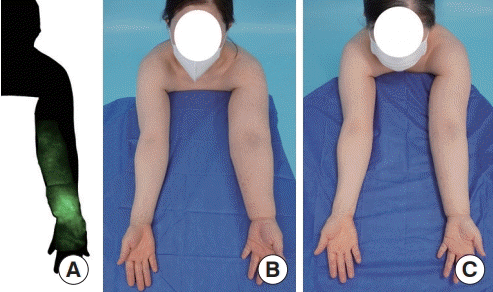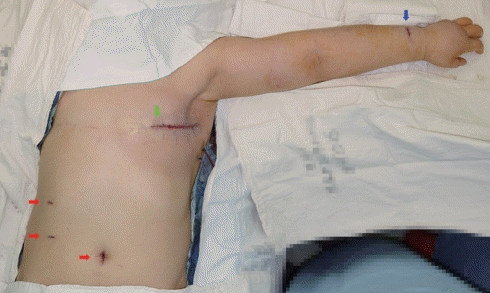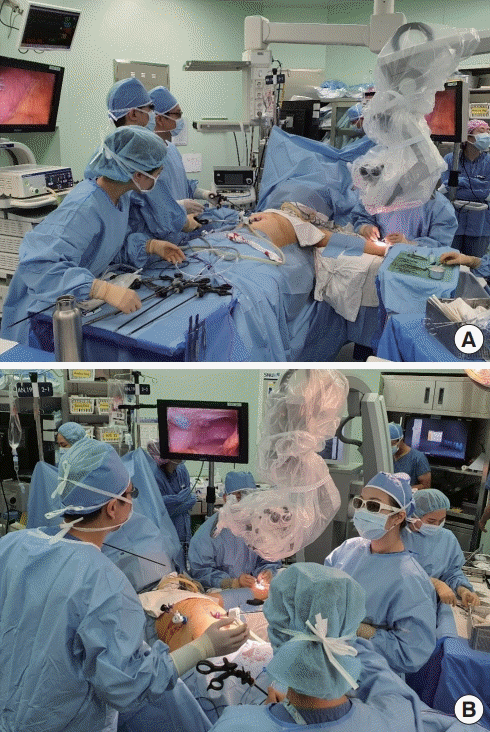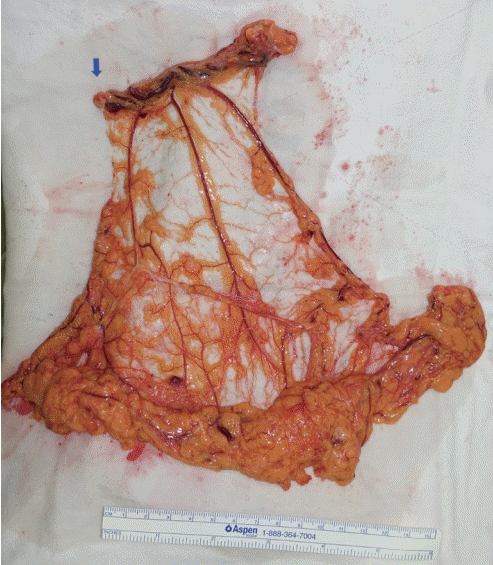Two-team approach in lymphovenous anastomosis and omental lymph node flap harvest for upper limb lymphedema
Article information
Vascularized lymph node transfer (VLNT) and lymphovenous anastomosis (LVA) can be performed simultaneously or independently, depending on the patient’s lymphedema stage [1]. A 54-year-old woman underwent bilateral total mastectomy in 2016, with sentinel lymph node biopsy for the right breast and axillary lymph node dissection for the left breast, followed by chemoradiotherapy. The patient developed progressive lymphedema (indocyanine green dermal stage IV–V), and LVA and VLNT were simultaneously performed (Fig. 1).

Indocyanine green lymphography (A), preoperative (B) versus postoperative 85-day (C) medical photographs.
The patient was laid supine and draped as illustrated in Fig. 2. First, the recipient vessels (thoracodorsal artery and vein) were prepared and complete scar tissue excision of the axilla and lateral chest was performed. A general surgeon then laparoscopically harvested an omental flap while a plastic surgeon performed LVA. With well-positioned monitors and microscope (Fig. 3), both the harvest and LVA were performed without interfering with each other’s operative field (Fig. 4). The upper part of the flap, with gastroepiploic lymph nodes, was inset in the axilla, and the remnant omental tissue was inset in the lateral chest.

Immediate postoperative image, illustrating draping and incision sites for lymphovenous anastomosis (blue arrow), vascularized lymph node transfer (green arrow), and laparoscopic omental harvest (red arrows).

(A, B) View of the operating room. With well-positioned displays and microscope, both plastic surgery and general surgery teams were able to operate without interfering with each other.
The advantages of the omental flap are minimal donor-site morbidity (e.g., iatrogenic lymphedema), the large diameter of the gastroepiploic vessels, and the potential for omental tissue to absorb lymphatic fluid [2]. Additionally, with the two-team approach, the overall operative time can be reduced by 1–3 hours compared to when other donor sites, such as the groin or submental space, are used. The patient reported improvement in swelling 2–3 days postoperatively and demonstrated fewer episodes of cellulitis and pruritis, along with a reduction in limb volume by approximately 20%, at 85 days postoperatively (Fig. 1).
Notes
Conflict of interest
No potential conflict of interest relevant to this article was reported.
Ethical approval
The study was approved by the Institutional Review Board of Seoul National University Bundang Hospital (IRB No. B-2009/637-702) and performed in accordance with the principles of the Declaration of Helsinki. Written informed consent was obtained.
Patient consent
The patients provided written informed consent for the publication and the use of her images.
Author contribution
Conceptualization: JK Park, Y Myung. Writing - original draft: JK Park. Writing - review & editing: Y Myung.

